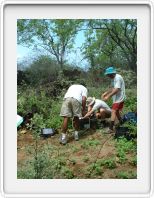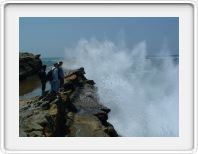Geophysics Research Opportunities
Our research groups focus on understanding fundamental, physical processes occurring within the
Earth’s mantle and lithosphere and on its surface. We study a wide variety of problems on many spatial and temporal scales, ranging from mantle upwelling to glacial dynamics. A list of research interests can be found under the About Us menu item. A few of the research questions that our faculty and students address include:
- What is the magnitude of forces that push on continents?
- What are the forces that reorganize oceanic plate boundaries?
- What are the pathways by which magma reaches volcanos at mid-ocean ridges, hotspots and arcs?
- What are the processes that make some faults weak?
- What is the rheology of faults?
- What controls how glaciers slide and produce erosion?
- How are mid-ocean ridges and hotspots related to global mantle flow?
Current Projects
Listed below are a few of the active projects within the department that address some of the scientific questions posed above. Financial support, often provided by the National Science Foundation, is provided for qualified graduate students.
The Mechanics of Slow Earthquakes and Fault Creep
Slow earthquakes are a special type of faulting where the slip rate is significantly lower than that observed during an earthquake. Observations over the past decade suggest that these events are more prevalent than previously appreciated. We are using observations of the slow earthquake source and numerical models of fault slip to better understand slow earthquakes. For more information on this project, contact Prof. Thomas.
Dynamic Weakening and Melting During Seismic Slip
Large reductions in fault strength can occur during earthquakes as a consequence of the rapid heating that results from mechanical work. In extreme cases, the temperature rise is expected to be sufficient to cause melting. However, despite the enormous quantities of energy that are released during large earthquakes along mature fault surfaces (those faults that have accommodated many km’s of slip and are distinguished by zones consisting of highly granulated gouge particles), evidence for melting is encountered only rarely. Current research by Prof. Rempel and his group is focused on understanding how fault strength evolves near the melting transition and whether melt onset itself might be self-regulating and impede subsequent temperature rise.
Glacier Sliding and Sediment Transport
Glaciers slide over thin melt layers that separate the ice from the underlying bedrock and sediments. The resistance to sliding and the incorporation of sediments into basal ice are both linked to the pressure distribution in these melt layers and the pore waters beneath. Research by Prof. Rempel and his group is focused on developing quantitative, predictive models that incorporate a modern understanding of the microphysics of melting and the controls on pore water pressure into descriptions of glacier sliding and sediment transport.
Volcano Magma Plumbing
The magma plumbing structure of volcanoes controls how magma moves through the crust, how the chemical composition of magmas change, and the nature of volcanic eruptions. Prof. Hooft uses the propagation of seismic waves through volcanoes to image these structures using state-of-the art travel time tomography and using full waveform inversion. Current research is focused on two back-arc volcanoes: a large recently-collected seismic dataset from Santorini volcano in Greece and ongoing studies at Newberry volcano in Oregon.
Mid-ocean Ridges and Interlinked Systems
Mid-ocean ridges are a primary site of mass and energy exchange between Earth’s mantle and hydrosphere and atmosphere. Prof. Toomey and Prof. Hooft study these feedback processes at the Endeavour segment of the Juan de Fuca ridge. We have tomographically imaged the magma plumbing system in the mantle and crust and the thermal boundary layer that transports energy between the magmatic and hydrothermal systems. Our experiment: (1) Determined that the segmentation and intensity of the magma-hydrothermal systems at the Endeavour ridge are related to the magma plumbing between the mantle and crust and not to magma supply; and (2) Constrained the thermal and magmatic structure underlying the Endeavour hydrothermal system in order to understand the patterns of energy transfer.
Photo Gallery:
Click on a thumbnail above to visit a photo gallery (Field Work, Scenery, Field Trips)


